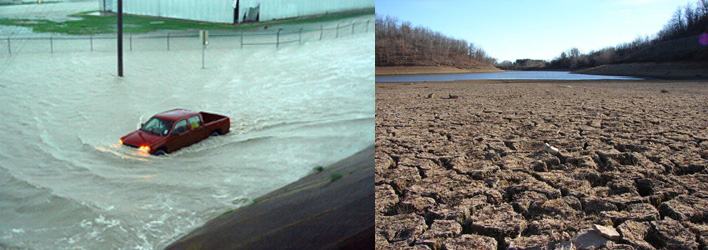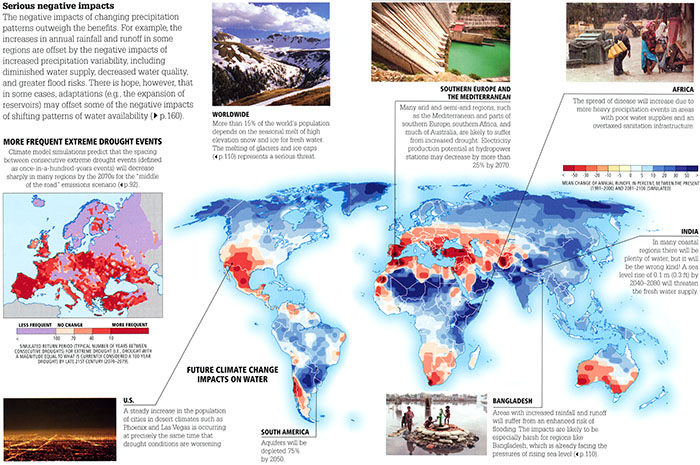Water is essential to life and it is essential to human civilization. Either too much or too little is a problem. And as we have seen in Lesson 7, climate change may, ironically, give us both.

As atmospheric circulation patterns and storm tracks shift, and changing rainfall patterns combine with the effects of changing evaporation and changing runoff patterns, one thing is for certain—water resources will be impacted. The greatest threat is the uncertainty of increasingly irregular and shifting patterns of precipitation.
In some regions, like the desert southwest of the U.S., climate change threatens to reduce fresh water availability due to both decreased winter rainfall and snowfall that ultimately feeds major reservoirs through spring runoff. Current projections are that Lake Powell, which provides southern Nevada with much of its fresh water supply, may run dry within a matter of decades, extrapolating recent drying trends. These decreases in water supply are on a collision course with demographic trends, as population centers, such as Las Vegas and Phoenix, continue to expand in size. Similar scenarios are likely to play out in Southern Europe and the Mediterranean, the Middle East, Southern Africa, and parts of Australia.
Other regions, meanwhile, are projected to get too much water. Bangladesh, already threatened by rising sea level, is likely to see increased flooding from the intense rainfalls expected with a warmer, more moisture-laden atmosphere.

- Serious Negative Impacts: The negative impacts of changing precipitation patterns outweigh the benefits. For example, the increases in annual rainfall and runoff in some regions are offset by the negative impacts of increased precipitation variability, including diminished water supply, decreased water quality, and greater flood risks. There is hope, however, that in some cases, adaptations (e.g. the expansion of reservoirs) may offset some of the negative impacts of shifting patterns of water availability.
- More Frequent Extreme Drought Events: Climate model simulations predict that the spacing between consecutive extreme drought events (defined as once-in-a-hundred-years events) will decrease sharply in many regions by the 2070s for the "middle of the road" emissions scenario.
- Future Climate Change Impacts on Water
- U.S. - A steady increase in the population of cities in desert climates such as Phoenix and Las Vegas is occurring at precisely the same time that drought conditions are worsening
- South America - Aquifers will be depleted 75% by 2050.
- Southern Europe and the Mediterranean - Many arid and semi-arid regions, such as the Mediterranean and parts of Southern Europe, Southern Africa, and much of Australia, are likely to suffer from increased drought. Electricity production potential to hydropower stations may decrease by more than 25% by 2070.
- Africa - The spread of disease will increase due to more heavy precipitation events in areas with poor water supplies and an overtaxed sanitation infrastructure.
- India - In many coastal regions there will be plenty of water, but it will be the wrong kind! A sea level rise of 0.1 m (0.3 ft) by 2040-2080 will threaten the fresh water supply.
- Bangladesh - Areas with increased rainfall and runoff will suffer from an enhanced risk of flooding. The impacts are likely to be especially harsh for regions like Bangladesh, which is already facing the pressures of rising sea level.
- Worldwide - More than 15% of the world's population depends on the seasonal melt of high elevation snow and ice for fresh water. The melting of glaciers and ice caps represent a serious threat.
© 2015 Pearson Education, Inc.
